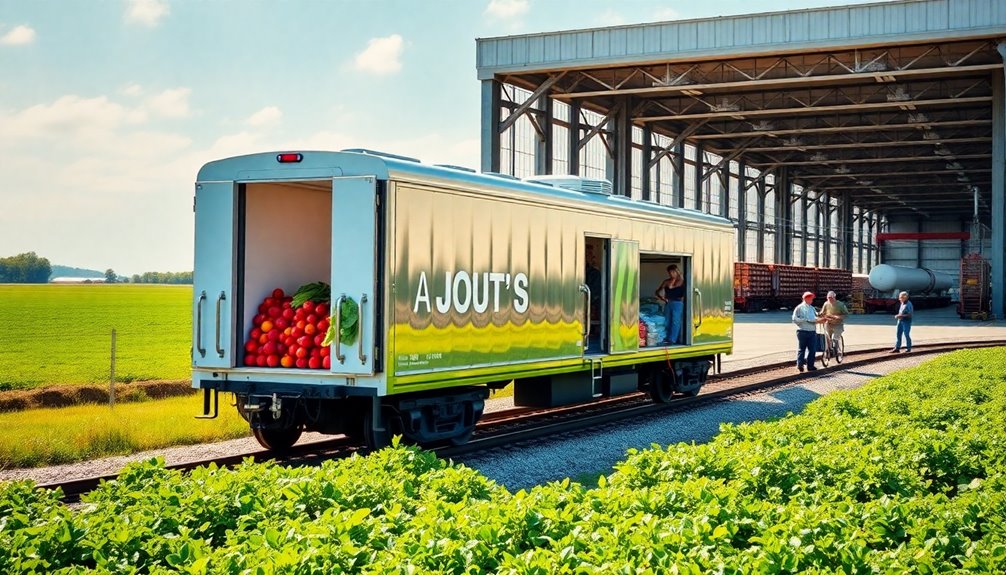The refrigerated railcar primarily impacted the meatpacking industry, transforming how perishable goods are transported. It allowed for long-distance shipment of meat, drastically reducing spoilage rates and ensuring higher quality. This innovation not only helped Chicago become a major meatpacking hub but also expanded market access for farmers. As fresh meats became available year-round, consumer preferences shifted towards fresh over preserved products, reshaping dietary habits. With these changes came economic growth and job creation in the transportation and logistics sectors. If you explore further, you'll discover more about the railcar's broader effects on agriculture and consumerism.
Key Takeaways
- The meatpacking industry was significantly transformed, with refrigerated railcars enabling long-distance transport and reducing spoilage rates.
- Agriculture experienced growth as farmers accessed broader markets, boosting profitability and expanding consumer options.
- Food distribution underwent a revolution, allowing year-round availability of fresh produce and meats, reshaping consumer habits.
- The logistics and transportation sectors benefited from job creation linked to the movement of refrigerated goods.
- Urban areas were transformed as fresh food became more accessible, influencing dietary habits and consumer spending patterns.
History of Refrigerated Railcars
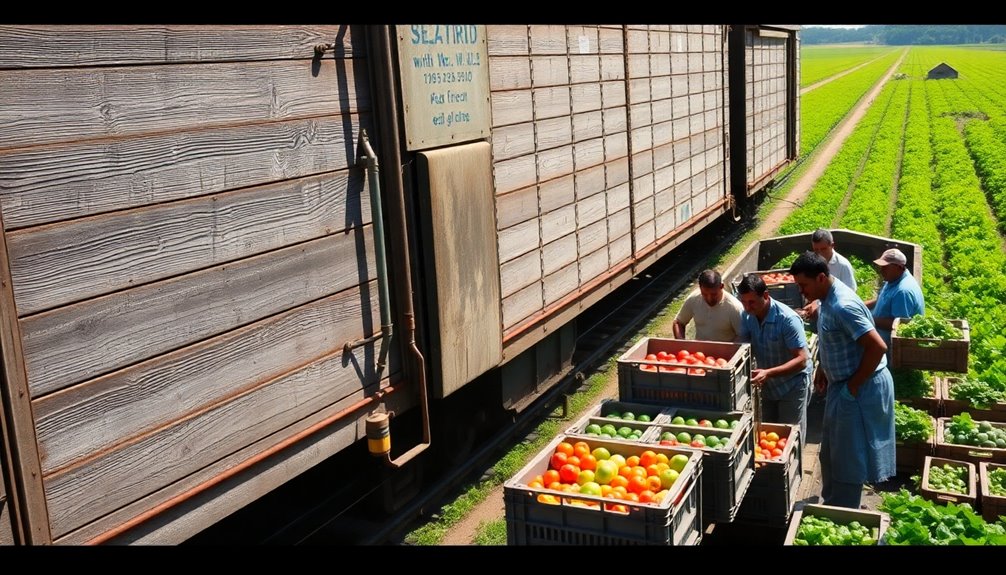
The history of refrigerated railcars marks a notable turning point in the transportation of perishable goods. In the late 19th century, the development of the first practical refrigerated railcar, known as the ice car, laid the groundwork for innovations in food transportation. This technology utilized ice for cooling, allowing the meat-packing industry to ship fresh products across long distances.
By 1881, mechanical refrigeration took hold, enhancing efficiency and reducing spoilage rates. The widespread use of refrigerated railcars transformed urban areas, increasing the availability of fresh food and changing American dietary habits.
Additionally, this advancement empowered farmers to access broader markets, boosting the profitability of perishable goods and expanding agribusiness notably.
Impact on Meatpacking Industry
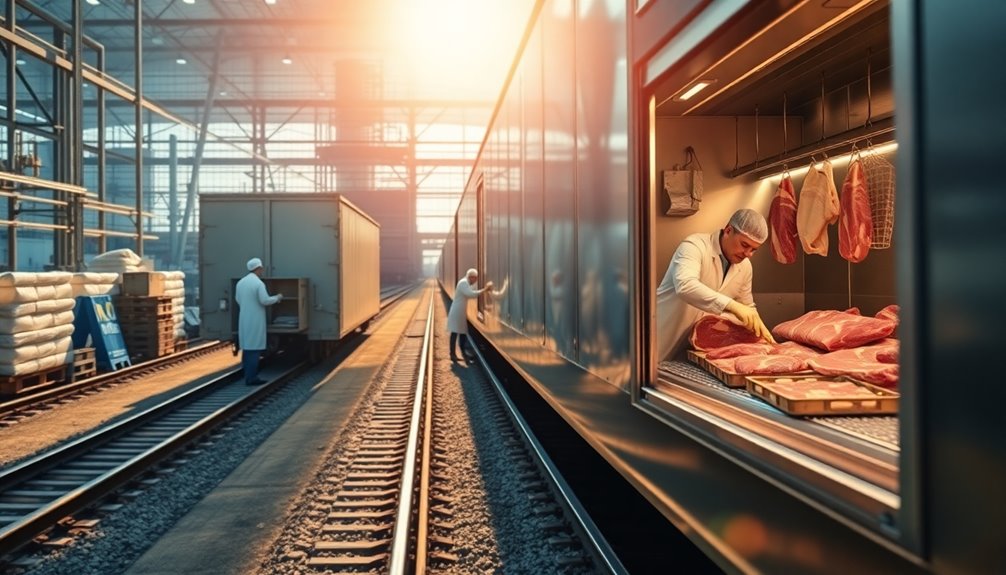
The introduction of refrigerated railcars transformed how you think about meat distribution.
Now, you can enjoy fresh, high-quality meat from far-off places, ensuring it reaches your table with the best possible freshness.
This innovation not only expanded your options but also raised standards in the meatpacking industry.
Long-Distance Meat Transport
Revolutionizing meat transport, refrigerated railcars introduced in 1881 drastically changed the meatpacking industry.
These refrigerated railcars enabled long-distance transport of fresh meat, expanding the market reach to consumers across the United States. Chicago became a central meatpacking hub, with the Union Stock Yards processing and shipping meat efficiently due to this innovation.
Before refrigerated transport, meat often spoiled during transit, but now, high-quality, perishable goods reached consumers safely. This shift also fueled the industrialization of food production, as meatpacking facilities adopted assembly line methods and a diverse workforce to maximize efficiency.
Consequently, the U.S. meatpacking industry grew considerably, transforming dietary habits by making a variety of meats accessible year-round. Additionally, the rise of sustainable and eco-friendly travel options has contributed to changing consumer preferences, further influencing the meatpacking sector.
Quality and Freshness Assurance
Quality and freshness assurance became paramount in the meatpacking industry with the advent of refrigerated railcars. Before their introduction, meat had to be consumed quickly after slaughter, limiting market reach.
Refrigerated railcars transformed this landscape, enabling safe long-distance transport without spoilage. This innovation allowed meatpacking plants to operate more efficiently, shipping large quantities of fresh meat across the United States.
As a result, the industry saw significant growth, particularly in Chicago, which emerged as a central hub for meat distribution. The assurance of quality through refrigerated transport built consumer trust, leading to increased demand and expansion in the meatpacking sector.
Today, that commitment to quality continues to define the industry's standards.
Changes in Food Distribution
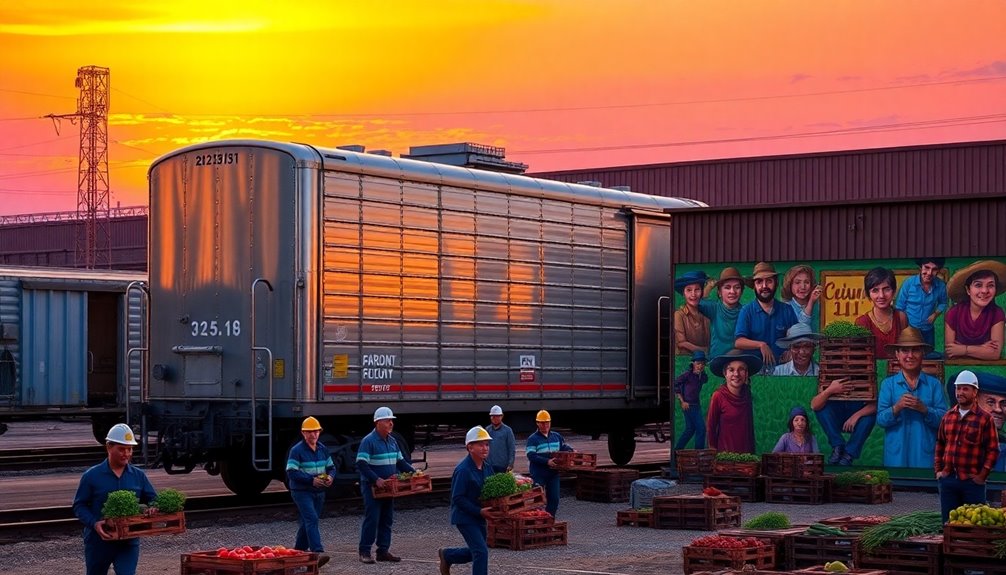
Refrigerated railcars changed the game for transporting perishable goods, allowing you to enjoy fresh food year-round.
With the ability to reach distant markets, you now have access to a wider variety of products, all while supply chains operate more efficiently.
This transformation not only enhanced your choices but also reshaped how food is distributed across the country. Moreover, the impact of this innovation can be seen in the financial implications of managing distribution costs and pricing strategies for perishable items.
Enhanced Perishable Goods Transport
The advent of refrigerated railcars transformed the landscape of food distribution, making it possible to transport perishable goods over vast distances without spoilage.
With this innovation, you can now enjoy a diverse range of perishable foods throughout the year. Here are some key changes brought about by refrigerated railcars:
- Year-round access to meats, dairy, and fresh produce
- Reduced food spoilage during transit
- Increased efficiency in the overall supply chain
- Enhanced profitability for rural agricultural producers
These advancements not only lowered food prices for consumers but also connected farmers to urban markets, fostering the growth of agribusiness. The ability to transport these goods efficiently has also led to a greater emphasis on energy efficiency in the supply chain, ensuring that resources are used optimally during transit.
The refrigerated railcar has consequently reshaped how we think about food distribution and consumption in modern society.
Expanded Geographic Food Markets
With the introduction of refrigerated railcars, food distribution underwent a dramatic shift, opening up new geographic markets for farmers and food producers.
Before this innovation, fresh meat and produce were confined to local sales. Now, you can enjoy a variety of perishable goods transported across the country, increasing your options at the grocery store.
The ability to ship these items year-round means exotic fruits and vegetables are just a railcar ride away, transforming consumer eating habits.
As a result, you benefit from a more diverse diet throughout the year.
This expansion of refrigerated transport not only enhances access to fresh food but also boosts agribusiness, allowing farmers to tap into broader markets and increase their profitability.
Improved Supply Chain Efficiency
An essential transformation in food distribution emerged with the advent of refrigerated railcars, greatly enhancing supply chain efficiency.
These innovations allowed for long-distance transport of perishables, revolutionizing the food supply chain and agribusiness. You now enjoy a diverse range of seasonal foods year-round, thanks to this technology.
Key benefits include:
- Drastically reduced spoilage rates of meat and dairy products
- Expanded markets for meatpacking plants, increasing competition
- Reliable transport of perishable goods over long distances
- Direct links between rural producers and urban consumers
With refrigerated railcars, food distribution became more integrated, allowing farmers to maximize profits and consumers to access fresher products. This shift not only changed eating habits but also strengthened America's overall food system, contributing to energy-efficient technology that supports sustainable practices in agriculture.
Economic Effects on Agriculture
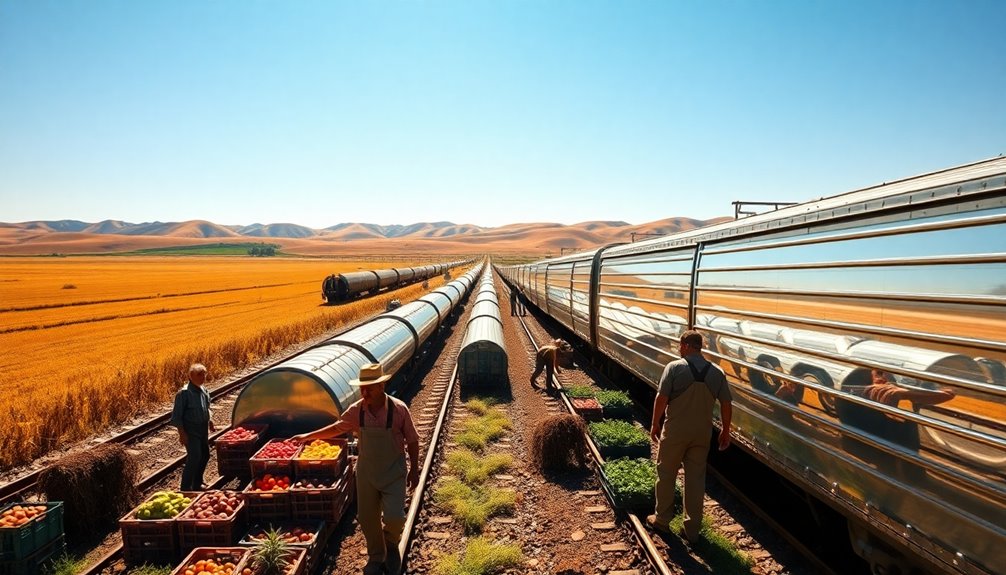
Refrigerated railcars revolutionized agriculture by greatly lowering food spoilage during transport, which allowed farmers to ship perishable goods like meat and dairy across the country.
This innovation considerably increased agricultural profitability, enabling year-round distribution of seasonal produce. Farmers could now access distant urban markets, transforming supply chain dynamics in agriculture.
The ability to transport perishable goods over long distances also facilitated the rise of large agribusinesses, empowering small-scale farmers to scale their operations and boosting rural economies.
Additionally, consumers enjoyed a diverse diet, gaining access to a wider variety of fresh produce and meats throughout the year.
The competition among food producers led to lower prices and prompted advancements in agricultural practices to meet the demand for fresh goods.
Influence on Consumer Habits
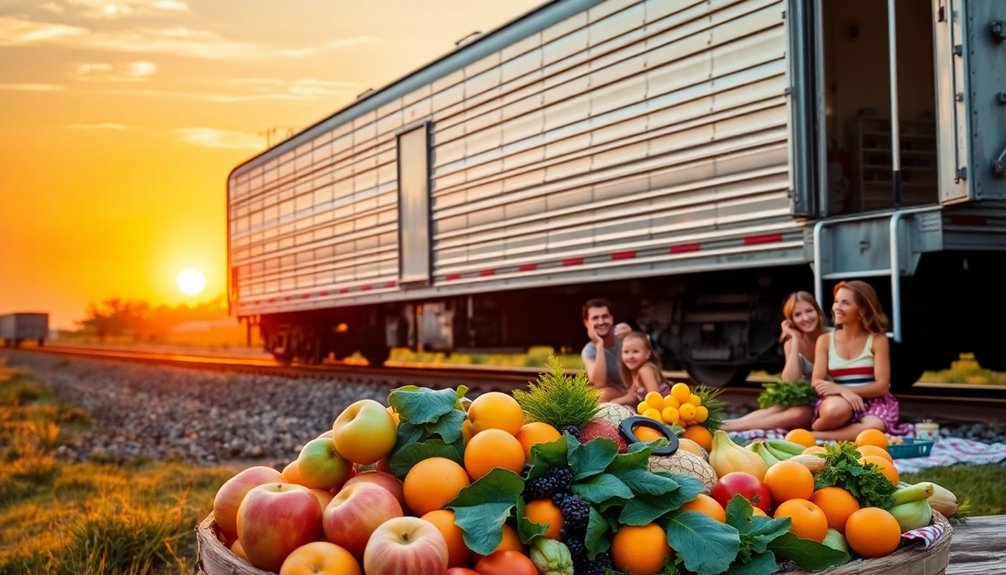
The introduction of refrigerated railcars drastically changed how you shop for food, making fresh produce and meats available year-round.
With this innovation, your access to perishable goods expanded, leading to new consumer habits. You likely started expecting a variety of food options, including:
- Exotic fruits and vegetables out of season
- Consistent availability of fresh meats
- Increased consumption of fresh over preserved items
- More competitive prices for perishable goods
As refrigerated railcars enabled producers to reach broader markets, you noticed food prices stabilizing and becoming more affordable.
This shift not only transformed what you could buy but also influenced how often you purchased fresh foods, shaping modern consumerism in profound ways.
Labor Relations in Meatpacking
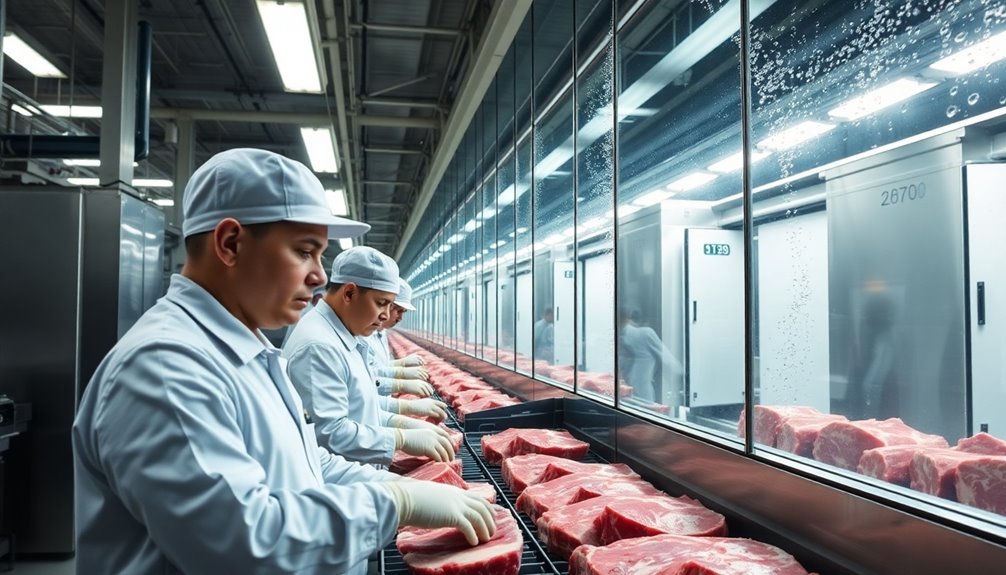
Labor relations in meatpacking have long been fraught with exploitation and challenge. Workers faced grueling 12-hour shifts for meager wages, struggling against high rents and poor conditions. This diverse workforce often found it hard to unionize due to divide-and-conquer tactics from industrialists. Despite initial successes, police frequently sided with employers, undermining union efforts. The publication of Upton Sinclair's "The Jungle" in 1906 shed light on these harsh realities, leading to legislative changes that improved safety and working conditions. However, the fight for labor rights persisted, culminating in the National Labor Relations Act of 1935, which empowered unions.
| Challenges | Impact on Workers | Legislative Changes |
|---|---|---|
| Exploitation | Long shifts, low wages | Federal Meat Inspection Act |
| Division among workers | Difficulty in unionizing | National Labor Relations Act |
| Police intervention | Reduced power | Advocacy for improved safety |
Future of Refrigerated Transport
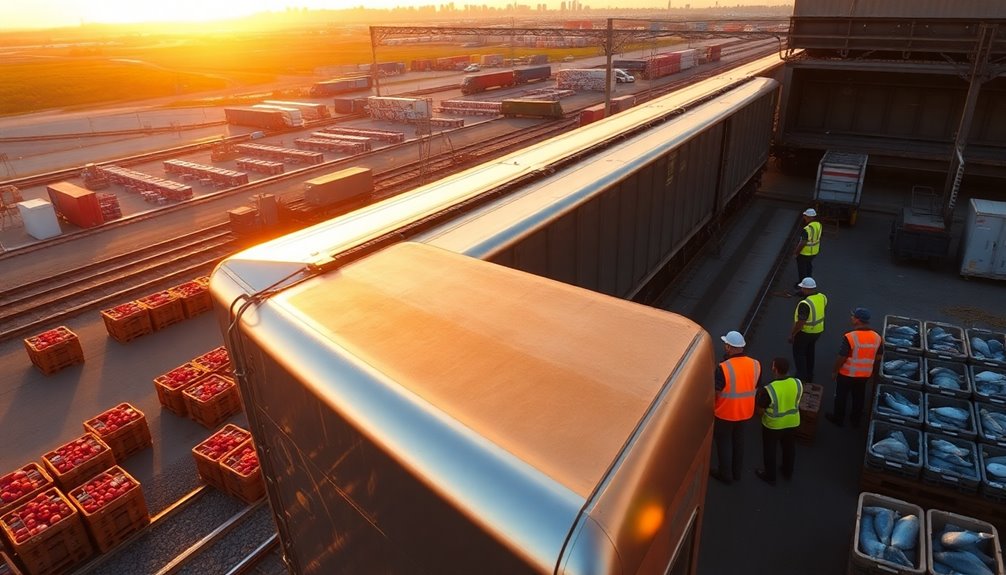
Advancements in refrigeration technology are set to revolutionize the transport of perishable goods, addressing both efficiency and environmental concerns.
As you look ahead, consider how these changes will impact refrigerated transport:
- Increased energy efficiency will reduce costs and carbon footprints.
- Eco-friendly materials and practices will enhance sustainability.
- Emerging technologies like blockchain and IoT will improve tracking and monitoring.
- Enhanced logistics will meet the growing demand for food safety and quality.
- The integration of solar energy solutions will further enhance the sustainability of refrigerated transport systems.
With globalization amplifying the need for reliable refrigerated transport, these innovations will guarantee that perishable goods remain fresh and safe.
As consumer expectations evolve, adapting to these changes is vital for maintaining food security and meeting market demands in a climate-conscious world.
Frequently Asked Questions
What Industry Did the Refrigerated Railcar Impact the Most?
The refrigerated railcar greatly transformed the meatpacking industry.
You'd see how it allowed for the long-distance transport of fresh meat, which had been limited due to spoilage concerns. This innovation enabled meatpackers to expand their distribution nationwide, boosting profits and market reach.
Additionally, it opened doors for shipping other perishable goods, revolutionizing agriculture and improving the overall efficiency of the American food supply chain, making diverse products available year-round.
What Industry Was Most Affected by the Refrigerator Real Car?
Imagine a world where fresh meat spoils before reaching your table. That's how it was before refrigerated railcars changed everything.
You'd see the meatpacking industry most affected by this innovation. With the ability to transport fresh meat long distances, producers expanded their markets and reduced spoilage.
Cities like Chicago thrived as meatpacking hubs, and you could enjoy fresh meats year-round, transforming your eating habits and supporting a booming agribusiness sector.
What Industry Was Most Affected by the Refrigerated Railcar Meatpacking Textile?
You might think about how the refrigerated railcar primarily impacted the meatpacking industry.
It revolutionized how meat was transported, enabling fresh products to reach distant markets without spoilage. This technology allowed meatpackers to expand their reach, greatly increasing production and sales.
While the textile industry also benefited from advancements in transportation, the meatpacking sector experienced the most dramatic changes, transforming food distribution and consumer habits across the nation.
What Industry Was Most Affected by the Refrigerated Railcar Brainly?
When you think about the impact of refrigerated railcars, the meatpacking industry stands out.
These innovative railcars transformed how fresh meat was transported, allowing companies to reach broader markets without worrying about spoilage.
You'd notice that meat became available year-round, changing consumer habits and preferences.
As a result, the meatpacking industry saw increased profits and reduced waste, ultimately revolutionizing food supply chains and contributing to agribusiness growth across the United States.
Conclusion
To summarize, refrigerated railcars revolutionized the meatpacking industry and transformed food distribution across the nation. Did you know that between 1860 and 1930, the amount of per capita meat consumption in the U.S. doubled? This shift not only boosted agricultural economics but also changed consumer habits greatly. As you reflect on this, consider how the innovations in refrigerated transport continue to shape our food systems today, making fresh produce and meats more accessible than ever before.

